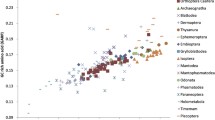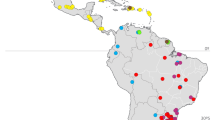Abstract
Homoptera and Heteroptera comprise a large insect assemblage, the Hemiptera. Many of the plant sap-sucking Homoptera possess unusual and complex life histories and depend on maternally inherited, intracellular bacteria to supplement their nutritionally deficient diets. Presumably in connection with their diet and lifestyles, the morphology of many Homoptera has become greatly reduced, leading to major controversies regarding the phylogenetic affiliations of homopteran superfamilies. The most fundamental question concerns whether the Homoptera as a whole are monophyletic. Recent studies based on morphology have argued that the Homoptera Sternorrhyncha (Aphidoidea, Coccoidea, Psylloidea, Aleyrodoidea) is a sister group to a group comprising the Homoptera Auchenorrhyncha (Fulgoroidea, Cicadoidea, Cercopoidea, Cicadelloidea) and the Heteroptera, making the Homoptera paraphyletic. We sequenced the 5′ 580-680 base pairs of small-subunit (18S) ribosomal DNA from a selection of Homoptera, Hemiptera, and their putative outgroups, the Thysanoptera and Psocoptera, to apply molecular characters to the problem of Homoptera phylogeny. Parsimony, distance, maximum-likelihood, and bootstrap methods were used to construct trees from sequence data and assess support for the topologies produced. Molecular data corroborate current views of relationships within the Sternorrhyncha and Auchenorrhyncha based on morphology and strongly support the hypothesis of homopteran paraphyly as stated above. In addition, it was found that Homoptera Sternorrhyncha have extra, GC-rich sequence concentrated in a variable region of the 18S rDNA, which indicates that some unique evolutionary processes are occurring in this lineage.
Similar content being viewed by others
References
Archie JW (1989) A randomization test for phylogenetic information in systematic data. Syst Zool 38:239–252
Boudreaux HB (1979) Arthropod phylogeny with special reference to insects. J Wiley and Sons, New York
Buchner P (1965) Endosymbiosis of animals with plant microorganisms. Interscience Publishers, New York, pp 297–332
Byrne DN, Bellows TS (1991) Whitefly biology. Annu Rev Entomol 36:431–457
Carmean D, Kimsey LS, Berbee ML (1992) 18S rDNA sequences and the holometabolous insects. Mol Phyl Evol 1:270–278
Carpenter FM (1992) Treatise on invertebrate paleontology. Vol 3, Superclass Hexapoda. The Geological Society of America, Boulder, CO, and the University of Kansas, Lawrence, KA
Carver M, Gross GF, Woodward TE (1991) Hemiptera (bugs, leafhoppers, cicadas, aphids, scale insects etc.). In: CSIRO (ed) The insects of Australia. A textbook for students and research workers, Vol I, 2nd ed. Melbourne University Press, Carlton, p 429
Cobben RH (1978) Evolutionary trends in Heteroptera. II. Mouthpartstructures and feeding strategies. Mededelingen Landbouwhogeschool, Wageningen, The Netherlands
Evans JW (1946) A natural classification of leaf-hoppers (Jassoidea, Homoptera). Pt 1. External morphology and systematic position. Trans R Entomol Soc Lond 96:47–60
Evans JW (1963) The phylogeny of the Homoptera. Annu Rev Entomol 8:77–94
Faith DP, Cranston PS (1991) Could a cladogram this short have arisen by chance alone?: on permutation tests for cladistic structure. Cladistics 7:1–28
Felsenstein J (1978) Cases in which parsimony and compatibility methods will be positively misleading. Syst Zool 27:401–410
Felsenstein J (1981) Evolutionary trees from DNA sequences: a maximum likelihood approach. J Mol Evol 17:368–376
Felsenstein J (1982) Numerical methods for inferring evolutionary trees. Q Rev Biol 57:379–404
Felsenstein J (1985) Confidence limits on phylogenies: an approach using the bootstrap. Evolution 39:783–791
Felsenstein J (1993) PHYLIP (phylogeny inference package). Version 3.5c. Distributed by the author. Department of Genetics, University of Washington, Seattle
Gawel NJ, Bartlett AC (1993) Characterization of differences between whiteflies using RAPD-PCR. Insect Mol Biol 2:33–38
Genetics Computer Group (1991) Program manual for the GCG package, version 7, April 1991. Madison, WI
Goodchild AJP (1966) Evolution of the alimentary canal in the Hemiptera. Biol Rev 41:97–140
Hamilton KGA (1981) Morphology and evolution of the rhynchotan head (Insecta: Hemiptera, Homoptera). Can Entomol 113:953–974
Hendriks L, Van Broeckhoven C, Vandenberghe A, Van de Peer Y, De Wachter R (1988) Primary and secondary structure of the 18S ribosomal RNA of the bird spider Eurypelma califomica and evolutionary relationships among eukaryotic phyla. Eur J Biochem 177:15–20
Hennig W (1981) Insect phylogeny. J Wiley and Sons, New York
Hillis DM, Dixon MT (1991) Ribosomal DNA: molecular evolution and phylogenetic inference. Q Rev Biol 66:411–453
Hodkinson ID (1974) The biology of the Psylloidea (Homoptera)—a review. Bull Entomol Res 64:325–339
Kishino H, Hasegawa M (1989) Evaluation of the maximum likelihood estimate of the evolutionary tree topologies from DNA sequence data, and the branching order in Hominoidea. J Mol Evol 29:170–179
Kramer S (1950) The morphology and phylogeny of auchenorhynchous Homoptera (Insecta). III Biol Monog 20:1–11
Kristensen NP (1973) The phylogeny of hexapod “orders.” A critical review of recent accounts. Z Zool Syst Evolut-forsch 13:1–44
Kristensen NP (1981) Phylogeny of insect orders. Annu Rev Entomol 26:135–157
Kristensen NP (1991) Phylogeny of extant hexapods. In: CSIRO (ed) The insects of Australia. A textbook for students and research workers, Vol I, 2nd ed. Melbourne University Press, Carlton, p 125
Kukalová-Peck J (1991) Fossil history and the evolution of hexapod structures. In: CSIRO (ed) The insects of Australia. A textbook for students and research workers, vol 1, 2nd ed. Carlton, Melbourne University Press, p 141
Kwon O, Ogino K, Ishikawa H (1991) The longest 188 ribosomal RNA ever known: nucleotide sequence and presumed secondary structure of the 188 rDNA of the pea aphid, Acyrthosiphon pisum. Eur J Biochem 202:827–833
Labandiera CC, Sepkoski JJ Jr (1993) Insect diversity in the fossil record. Science 261:310–315
Lyal CHC (1985) Phylogeny and classification of the Psocodea, with special reference to the lice (Psocodea: Phthiraptera). Syst Entomol 10:145–165
MacGavin GC (1993) Bugs of the world. Facts on File, New York
Maddison WP, Maddison DR (1992) MacClade. Analysis of phylogeny and character evolution. Version 3. Sinauer Associates, Inc., Sunderland, MA
Miller DR, Kosztarab M (1979) Recent advances in the study of scale insects. Annu Rev Entomol 24:1–27
Moran NA (1992) The evolution of aphid life cycles. Annu Rev Entomol 37:321–348
Moritz C, Dowling TE, Brown WM (1987) Evolution of animal mitochondrial DNA: relevance for population biology and systematics. Annu Rev Ecol Syst 18:269–292
Munson MA, Baumann P, Clark MA, Baumann L, Moran NA, Voegtlin DJ, Campbell B (1991) Evidence for the establishment of aphideubacterium endosymbiosis in an ancestor of four aphid families. J Bacteriol 173:6321–6324
Nault LR, Rodriguez JG (1985) The leafhoppers and planthoppers. J Wiley and Sons, NY
Nei M (1991) Relative efficiencies of different tree-making methods for molecular data. In: Miyamoto MM, Cracraft J (eds) Phylogenetic analysis of DNA sequences. Oxford, New York, pp 90–128
Nelles L, Fang BL, Volckaert G, Vandenberghe A, De Wachter R (1984) Nucleotide sequence of a crustacean 18S ribosomal RNA gene and secondary structure of eukaryotec small subunit RNAs. Nucleic Acids Res 12:8749–8768
Nur U (1971) Parthenogenesis in coccids (Homoptera). Am Zool 11: 301–308
Ossianilsson F (1981) The Auchenorrhyncha (Homoptera) of Fennoscandia and Denmark. Pt 2. The families Cicadidae, Cercopidae, Membracidae, and Cicadellidae (excl. Deltocephalinae). Fauna Entomol Scand 7:223–593
Poisson R, Pesson P (1951) Super-ordre des Hémiptéroides (Hemiptera Linné, 1758, Rhynchota Burmeister, 1835). In: Grassé P-P (ed) Traité de Zoologie: Anatomic, Systématique, Biologic. Tome X. Insectes superieurs, et Hémiptéroides. 2 vols. Masson, Paris, pp 1–975,976–1948
Ross HH (1955) The evolution of insect orders. Entomol News 66: 197–208
Ross HH (1965) A textbook of entomology, 3rd ed. Wiley, New York
Saiki RK, Gelfand DH, Stoffel S, Scharf J, Higuchi R, Horn GT, Mullis KB, Erlich HA (1988) Primer-directed enzymatic amplification of DNA with a thermostable DNA polymerase. Science 239:487–491
Saitou N, Nei M (1987) The neighbor-joining method: a new method for reconstructing phylogenetic trees. Mol Biol Evol 4:406–425
Schlee D (1969) Bau and Funktion des Aedeagus bei Psyllina und deren Bedeutung fur systematische Untersuchungen. Phylogenetische Studien an Hemiptera 111. Entkräftung eines Arguments gegen die Monophylie der Sternorrhyncha. Z Morphol Tiere 64:139–150
Scudder GGE (1973) Recent advances in the higher systematics and phylogenetic concepts in entomology. Can Entomol 105:1251–1263
Sogin ML, Elwood HJ, Gunderson JH (1986) Evolutionary diversity of eukaryotec small-subunit rRNA genes. Proc Natl Acad Sci USA 83:1383–1387
Swofford DL (1993) PAUP: phylogenetic analysis using parsimony, version 3.1. Computer program distributed by the Illinois Natural History Survey, Champaign, IL
Szelegiewicz H (1971) Autapomorphous wing characters in the recent subgroups of Sternorrhyncha (Hemiptera) and their significance in the interpretation of the Paleozoic members of the group. Ann Zool 29:1–67
Tautz D, Hancock JM, Webb DA, Tautz C, Dover GA (1988) Complete sequences of the rRNA genes of Drosophila melanogaster. Mol Evol Biol 5:366–376
Theron JG (1958) Comparative studies on the morphology of male scale insects (Homoptera: Coccoidea). Ann Univ Stellenbosch 34: 1–71
Vossbrinck CR, Maddox JV, Friedman S, Debrunner-Vossbrinck BA, Woese CR (1987) Ribosomal RNA sequence suggests microsporidia are extremely ancient eukaryotes. Nature 326:411–414
Wheeler WC, Schuh RT, Bang R (1993) Cladistic relationships among higher groups of Heteroptera: congruence between morphological and molecular data sets. Entomol Scand 24:121–137
Wootton RJ (1981) Paleozoic insects. Ann Rev Entomol 26:319–344
Wootton RJ, Betts CR (1986) Homology and function in the wings of Heteroptera. Syst Entomol 11:389–400
Author information
Authors and Affiliations
Additional information
Correspondence to: C.D. von Dohlen
Rights and permissions
About this article
Cite this article
von Dohlen, C.D., Moran, N.A. Molecular phylogeny of the homoptera: a paraphyletic taxon. J Mol Evol 41, 211–223 (1995). https://doi.org/10.1007/BF00170675
Received:
Accepted:
Issue Date:
DOI: https://doi.org/10.1007/BF00170675




